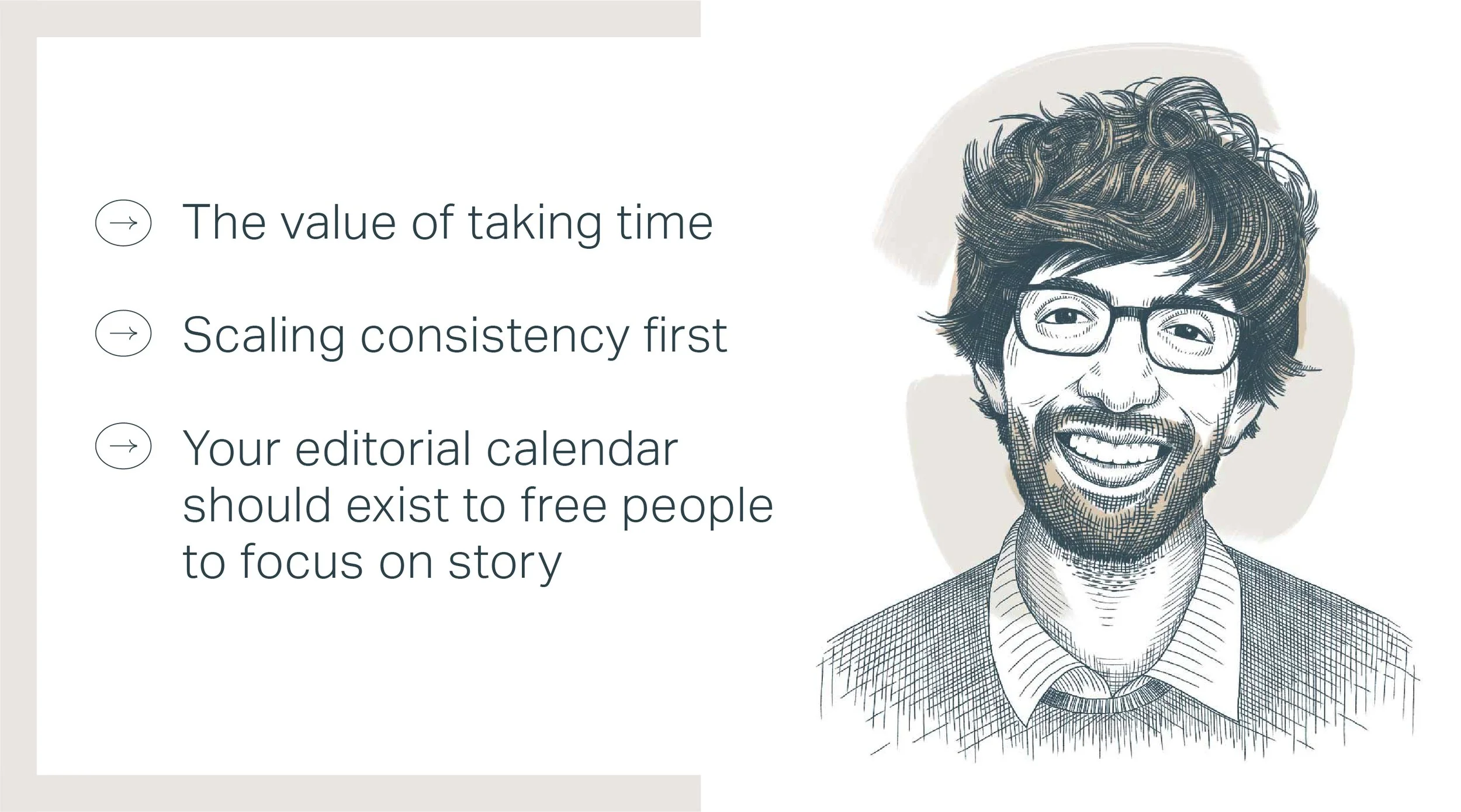
Whenever I meet Suhas over Zoom, he sits calm and poised before a backdrop of dew on fluorescent green grass. He always asks how I am. He always listens to my response. He has never, to my recollection, needed to hop to the next call.
You would never guess he was part of a large, frenetic, public company doing many things of great import. In writing about content operations, I had to invite his perspective, and ask how he thinks about enforcing and cultivating high quality writing and design in such a busy business—and remains so collected throughout.
In our interview, he talks about the value of taking time, scaling consistency first, and why tools like your editorial calendar should exist to free people to focus on story.
Suhas is Director of Content Operations at Coupa, a 3,000-person financial software firm that went public in 2016. This conversation has been edited lightly for brevity.
When you go in-house, you learn things you were never aware of
Suhas: I studied engineering, which led to science journalism, which led to freelance writing through an early freelancing platform called Contently. Writing for companies felt like an extension of journalism, but paid more.
I really enjoyed the freedom and was perfectly happy freelancing. But as life goes, as soon as you have that mindset, something comes your way where you think, “Oh, this is the opposite of what I was thinking, but it’s intriguing.” The supply chain technology company GT Nexus made me a full-time offer, and I took it.
As an in-house content marketer, there were so many things I just hadn’t been aware of as a freelancer. The biggest one was, inside a company, there are so many different messages people want to put out into the world, and you have to prioritize which ones get produced. I never got to see that as a freelancer. Contracting, you’re handed a semi-baked assignment. It might change slightly, but it’s mostly fixed. When you’re in-house, you have to decide which of all those messages to bring to light. That’s a whole different skill set.
"When you’re in-house, you have to decide which of all those messages to bring to light."
Content payoffs take time
Suhas: My favorite project I participated in at GT Nexus was the Supply Chain Radio podcast. It was a fun and, at that time, a non-intrusive way to talk about the issues our platform addressed. We had people who deeply understood the challenges and solutions, but it was casual and off the cuff. Over three or four years, that audience grew to a pretty impressive number.
It was one of those things you start off doing just because you think it’s an interesting way to present the content. But that consistent effort, and doing it over a long period, was the first time I’d seen that pay off. I realized, if you really want to build something, you have to do it consistently.
"If you really want to build something, you have to do it consistently."
Quality is simplicity
Suhas: The question of quality is an interesting one. I’ve always been fascinated by films and novels, and think really hard about why I like particular movies and books. Why are some good, versus all the stuff I don’t feel connected to? For me, it comes down to the way they present their message.
I think every company has some fundamental message with some integrity to it. Otherwise, it probably wouldn’t still exist, or wouldn’t last long. But it’s the way they convey that message that determines whether their content is high quality or not. There has to be a real simplicity to what you're communicating—and getting to that point is actually quite difficult. It requires you as the content creator to understand the subject deeply enough to cut out things and leave just the essentials, tightly strung together.
That’s always going to require a process for conscientious editing. Something that ensures you are consistently communicating an idea without overcomplicating it.
(For an example of a good message, albeit not in B2B, look at Reverb.)
Then there’s presentation
Suhas: There’s another dimension I call presentation, which is you might have the substance, you might even have the simplicity, but if the experience of getting to it is unintuitive and unengaging, then you're going to lose out. You can write a great novel that nobody picks up off the bookshelf because of the bad cover.
In content, you want to ensure that every step of that user's journey of getting to and enjoying your content feels good. It actually has a lot of overlap there with user experience (UX) design.
You can’t scale quality, but you can scale consistency
Suhas: There's an old adage, "If a business isn't growing, it's dying.” I think companies’ fascination with “scale” gets at the very heart of being in business. They exist to grow.
Thus, when people talk about “scaling” marketing or content, the idea is usually to also do more. But in content, you always have finite resources. You can either invest that into increasing the quality to make a better product or you can increase the volume and publish more. If people expect you to do both at once it’s going to fall apart.
Most companies are going to expect volume, and most leaders will understand that best, so I recommend starting there. First address volume without touching quality. Do one thing well. Once you have the volume, you can adjust, because you’ll eventually master it and things will plateau. You’ll reach a point where you're delivering enough to satisfy the business. That’s when you can reevaluate and say, “You know, I think we have enough. Now let’s put that next burst of effort into improving quality.” And rather than increase how much you’re publishing, you focus on making everything you already do better.
"First address volume without touching quality. Do one thing well."
Satisfy stakeholders without losing your “why”
Suhas: Marketing organizations are usually set up in a way that everybody has one piece of the pie and the connections between those pieces are somewhat nebulous. That raises a lot of questions about what you’re trying to achieve with each project.
My way to approach this is yes, figure out what each stakeholder expects, and aim to do some of that because those expectations will determine how successful everyone feels you were. But don’t forget about the other side, which isn’t explored as often, which is, “What do we have to say?” And there, I think about Simon Sinek’s book, Start With Why. What is the unique thing that you want to put out into the world? Is that a strong enough idea? Is that a strong enough point of view that it can carry through everything you produce and act as an organizing principle?
That second part tends to get lost in larger companies with multiple products and many acquisitions. They lose their unique stance. People get caught up in producing and not asking why.
If you do have that singular vision, you know what to say to any given persona or audience at any given time and it makes creating easy.
Do have an editorial calendar—maybe multiple
Suhas: I'm a big believer in editorial calendars. I think you need one or multiple that serve as a board to show everyone where things are headed. Whether you do that in Asana or Slack or spreadsheets, it’s one place you can communicate. It tells stakeholders, “These are the stories we’re telling, and here’s everything that’s going on right now.”
I’m also a huge believer in connected content journeys, and I think calendars help with that. If all your communications are displayed in one place, you can be sure whatever everyone is producing ties to your overall vision. You can see a blog post and article and make connections between them, and that makes for a good user experience.
Keep things as consistent as possible
Suhas: As far as keeping everybody aligned, I think it's really important to make all of those things, the software, the meetings, the calendars, as regular as possible. Save people from worrying about the mechanics of Asana, or what sessions to attend. Set it and try not to shift it.
Operations help everyone focus on story
Suhas: If you get the mechanics down to organizational muscle memory, you can focus everyone’s energy on storytelling, and improving the storytelling. I like the idea of a writer’s room, and having a place where people can ask questions, get unstuck, and help each other tell better stories.
No content person wants to spend the next several years perfecting Asana. I for one would love to focus my year on the art of storytelling across different media. I think there's a huge opportunity to look at the landscape of how people are consuming content, and not just written content— video, podcasts, infographics, and all of that stuff. And where are people finding it? How are they thinking about news? Apps? Social? Can we go to where they are, poke our head in, offer something, and have a presence?
I think when you have the simplicity, the presentation, and the content operations, it frees people to focus on the right questions.

Keep up with Suhas on LinkedIn.
If you read one book that helps with your content career, he recommends Killing Marketing by Joe Pulizzi.
More on Content Operations:
- The 50,000-Eyeball Open Rate—A Conversation with Caleb Newquist
- Purge Ruthlessly Every Six Months—A Conversation with Kathryn Bennett
- Messaging Four Audiences at Once—A Conversation with Yoni Argaman
- Forgo Anything Fancy—A Conversation with Jillian Wood
- The Path to Narrative-market Fit—A Conversation with Christine Deakers
- Content Operations 101




